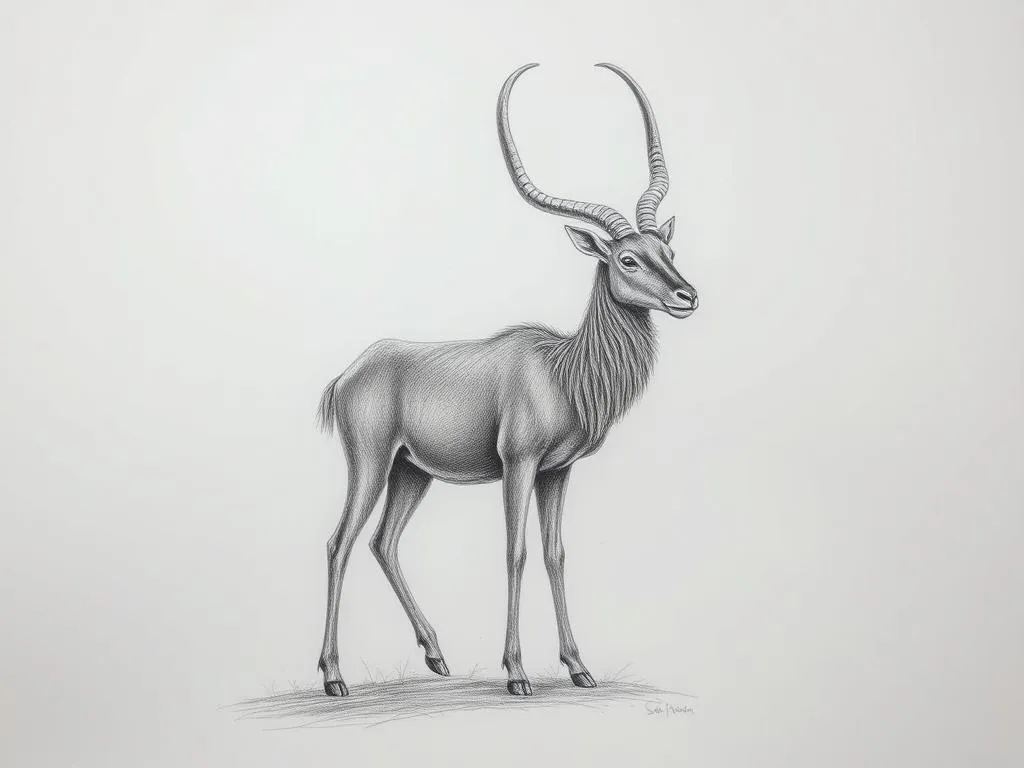The Sambar: Symbolism and Spiritual Significance

Disclaimer: Some images on this website are AI-generated artworks and may not accurately represent real animals.
Understanding the Sambar
Physical Characteristics
The sambar (Cervus unicolor) is a large deer species known for its distinctive appearance and impressive stature. Below is a summary of its physical characteristics:
| Feature | Description |
|---|---|
| Size | Males weigh between 180-250 kg; females are lighter, around 100-150 kg. |
| Height | Stands approximately 90-120 cm at the shoulder. |
| Coat Color | Typically brown to gray, with a lighter underbelly. |
| Antlers | Males possess large, branched antlers, which can grow up to 100 cm long. |
| Distinctive Features | Notable for its large, rounded ears and long legs. |
The sambar’s robust body and large, elongated ears help it navigate the dense forests of its habitat. Its coat serves as excellent camouflage among the shadows of the woods, allowing it to blend seamlessly into its surroundings.
Habitat and Distribution
Sambars are predominantly found in the forests of South and Southeast Asia, including India, Nepal, Bhutan, Sri Lanka, and parts of Southeast Asia. They thrive in a variety of environments, typically preferring:
- Deciduous and evergreen forests
- Grasslands adjacent to woodlands
- Hilly terrains and mountainous regions
- Marshy areas near rivers and lakes
These habitats provide them with ample food sources, such as leaves, fruits, and grasses, while also offering cover from predators. Their adaptability to different ecological zones is one reason for their broad distribution.
Behavior and Social Structure
Sambars exhibit interesting social behaviors that contribute to their survival. They are primarily solitary animals but can be seen in small groups, especially during mating seasons. Their social structure consists of the following characteristics:
- Herd Dynamics: Females often form small groups with their young, while males tend to be more solitary, coming together only during the breeding season.
- Mating Rituals: During the rutting season, males engage in vocalizations, displaying their antlers and engaging in physical confrontations to attract females.
- Communication: Sambars communicate through a variety of sounds, including grunts and barks, and their body language plays a significant role in social interactions.
Understanding the behavior of sambars provides insight into their role in the ecosystem and their interactions with other wildlife.

Symbolism & Spiritual Meaning
Connection to Nature
The sambar embodies a deep connection to the wilderness, symbolizing untamed nature and the beauty of the natural world. They are often seen as:
- Emblems of Freedom: Their ability to roam vast territories signifies a spirit of independence and freedom.
- Representatives of the Wild: Sambars serve as reminders of the untouched forests and the importance of preserving natural habitats.
In various cultures, sambars are revered as symbols of nature’s raw beauty, inspiring individuals to seek harmony between themselves and the environment.
Grace and Agility
The elegance and agility of the sambar further contribute to its symbolic significance. With their graceful movements and remarkable speed, sambars are often associated with:
- Elegance: Their fluid motions in the forest reflect a sense of grace that many cultures admire.
- Adaptability: The ability of sambars to navigate through dense underbrush represents the importance of flexibility and resilience in life.
In various artistic representations, sambars are depicted as embodiments of beauty and finesse, inspiring people to embrace grace in their own lives.
Guardians of the Forest
As crucial members of their ecosystems, sambars play a vital role in maintaining the balance of their habitats. They are often seen as guardians of the forest, symbolizing:
- Biodiversity: Sambars contribute to the health of the forest by participating in the food chain and supporting various plant species through their grazing habits.
- Conservation: Their presence in an area can indicate a healthy ecosystem, making them symbols of conservation efforts aimed at preserving wildlife and natural habitats.
This guardianship aspect of the sambar emphasizes the interconnectedness of all living things and the responsibility of humans to protect the natural world.
Sambar in Dreams
Interpreting Sambar Sightings
Dreaming about a sambar can evoke various feelings and interpretations. Here are some common themes associated with sambar sightings in dreams:
| Theme | Interpretation |
|---|---|
| Freedom | Representing a desire for independence or exploration. |
| Connection to Nature | A reminder to reconnect with the natural world and its beauty. |
| Personal Growth | Symbolizing transformation and the pursuit of personal goals. |
These themes offer valuable insights into the subconscious mind, encouraging dreamers to reflect on their lives and aspirations.
Messages from the Spirit World
The appearance of a sambar in your dreams may carry significant messages from the spirit world. Common interpretations include:
- Guidance: The sambar may be urging you to trust your instincts and follow your path.
- Protection: Their presence could signify that you are being watched over and supported by unseen forces.
- Awakening: A sambar dream may encourage you to awaken your instincts and reconnect with your true nature.
Understanding these messages can provide clarity and direction in your waking life.
Personal Growth and Transformation
Utilizing the symbolism of the sambar can inspire personal growth and transformation. Here are ways to reflect on this symbolism:
- Embrace Change: Like sambars adapting to their environment, be open to change and new experiences.
- Seek Balance: Find harmony within yourself and your surroundings, drawing inspiration from the sambar’s connection to nature.
- Cultivate Grace: Strive for elegance in your actions, relationships, and personal pursuits.
By reflecting on these aspects, individuals can harness the transformative energy of the sambar to enhance their personal journeys.
Modern Interpretations
Cultural Significance
Across different cultures, the sambar holds varying significance. In some traditions, sambars are celebrated for their majestic presence and roles in folklore. Key cultural interpretations include:
- Mythology: In certain myths, sambars are depicted as wise beings that guard the forest and protect its inhabitants.
- Folklore: Stories of sambars often revolve around their graceful movements, symbolizing the importance of respecting nature.
These cultural narratives contribute to the sambar’s status as a symbol of natural beauty and resilience.
Sambar in Art and Literature
The sambar has inspired various forms of artistic expression, appearing in literature, paintings, and sculptures. They are often portrayed as:
- Symbols of Wilderness: Artists capture their essence as representations of untamed nature and freedom.
- Motifs of Transformation: In literature, sambars may symbolize characters undergoing personal journeys or transformations.
These artistic representations reflect the sambar’s deep-rooted symbolism and its impact on human creativity.
Conservation Efforts and Symbolism
In recent years, the sambar has become a symbol for wildlife conservation, highlighting the urgent need to protect their habitats. Conservation efforts often emphasize:
- Awareness: Raising awareness about the importance of biodiversity and the role of sambars in their ecosystems.
- Protection Initiatives: Supporting efforts to safeguard their natural habitats and mitigate human-wildlife conflict.
By embracing the sambar as a symbol of conservation, individuals can contribute to the protection of wildlife and the natural world.
Key Takeaways
- The sambar symbolizes a deep connection to nature and the wilderness.
- Their grace and agility serve as reminders of elegance and adaptability.
- Sambars act as guardians of the forest, highlighting the importance of biodiversity.
- Dreams involving sambars can offer insights into personal growth and transformation.
- Cultural interpretations and artistic representations showcase the sambar’s significance in various contexts.
- Conservation efforts emphasize the urgent need to protect sambars and their habitats.
Conclusion
Understanding the sambar symbolism enriches our appreciation of this magnificent creature and its role in the natural world. By reflecting on its spiritual significance, we can gain insights into our own lives, fostering a deeper connection with nature and wildlife. The sambar reminds us of the urgency to protect our environment and the beauty that resides within it. Through this understanding, we can inspire others to appreciate and safeguard the precious ecosystems that sambars inhabit.







